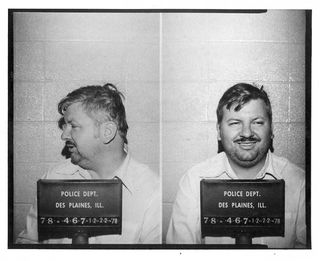Psychopathy
John Wayne Gacy: The Diabolical “Killer Clown”
Successful businessman, husband, lover of children — and psychopathic killer.
Posted May 19, 2014 Reviewed by Lybi Ma

A serial killer is frequently an unassuming everyman who could easily be a next-door neighbor or co-worker. Such was the case of the late John Wayne Gacy, a prolific and psychopathic serial killer born in Chicago in 1942. He was named after his mother’s favorite Hollywood movie star, the legendary John “Duke” Wayne.
As a young adult, the outgoing and sociable Gacy became a successful building contractor and a married man and father. He was well known and respected in his suburban Chicago community. He became heavily involved in local politics and was named Jaycee (Junior Chamber of Commerce) “Man of the Year.” He even escorted President Jimmy Carter’s wife, Rosalyn, on one of her visits to Chicago.
John Wayne Gacy was also a ruthless predator who tortured, raped, and strangled 33 young men between 1972 and his arrest in 1978. He buried 29 of his victims in a crawl space under his house.
Gacy was caught after a surveillance detective assigned to the case noticed a suspicious smell emanating from a heating duct in his home. The floorboards of Gacy’s house shook as forensic anthropologists attempted to excavate the 29 bodies buried in the crawl space, due to millions of worms that were feeding on the corpses.
Gacy pled not guilty by reason of insanity but was determined to be legally sane by the court. He was convicted of the serial rape and murder of his victims and sentenced to death on March 13, 1980.
Gacy became known as “the Killer Clown," because his favorite pastime when he was not killing involved entertaining children at parties and hospitals dressed in a clown costume and full-face makeup. His clown alter-ego was named Pogo.
The late FBI profiler Robert Ressler, who interviewed Gacy after his conviction, said Gacy told him that his victims were “worthless little queers and punks.” Ressler challenged him on that statement, asking, “Aren’t you a homosexual, too?” Gacy responded that his victims were young runaways, while he was a respected and successful businessman. Gacy also explained that he was too busy at work to date and romance women following his divorce, so he settled for quick sex with transient young men.
Unremorseful to the end, Gacy’s final words before being executed by lethal injection on May 10, 1994, were "Kiss my ass."
Another intriguing aspect of John Wayne Gacy’s story is that he became a prolific artist while waiting to be executed on death row. His clown paintings are highly desired by so-called murderabilia collectors, and his individual works command prices as high as $25,000 each at art auctions. See my related article: "The Strange Hobby of Collecting 'Murderabilia.'"
The stories of real-life serial killers, such as John Wayne Gacy, seem to captivate the public. An important aspect of the public’s fascination with serial killers has to do with the fact that prolific serial killers often blend into society very effectively and for long periods of time.
The reality of a mild-mannered and stone-cold psychopath, such as John Wayne Gacy, is nothing like the serial killer stereotype generally presented in the news and entertainment media. In person, killers like Gacy come across as average guys, even charming, not like predatory monsters.
This unexpected contradiction is both intriguing and terrifying to people. As noted by Dr. Jeffrey Walsh, a criminal justice professor at Illinois State University:
They [serial killers] tend to blend into society relatively efficiently… that’s another thing people are disturbed by. Because of how horrible their acts often are, we sometimes think they look different than us or that we would recognize them. The fact is, many of them have regular lives and blend in, so they don’t meet the stereotypical views of what a monster would be like.
The fact that serial killers can blend in so effectively is horrifying to many people because it means that anyone could be a serial killer. Because of their uncanny, chameleon-like skills at blending in, several high-profile serial killers have been dubbed “the killer next door” by the news media over the years, including Ted Bundy and Dennis Rader (BTK).
I discuss the motivations, fantasies, and habits of notorious serial killers, including the “Son of Sam” and “Bind, Torture, Kill” based on my personal correspondence with them, in my best-selling book Why We Love Serial Killers: The Curious Appeal of the World’s Most Savage Murderers.




